#wingsail
Explore tagged Tumblr posts
Text
La resurrección de la vela
El 4 de julio de 2021, tal y como estaba anunciado por la prensa especializada, hacía su primera escala al puerto de Barcelona el ferry GNV Bridge perteneciente a la compañía italiana Grandi Navi Veloci (GNV) y que a partir de ese momento pasaría a conectar Barcelona con Palma e Ibiza. Con este barco y el GNV Sealand la compañía italiana comenzaba una nueva etapa sumándose en esta ruta,…
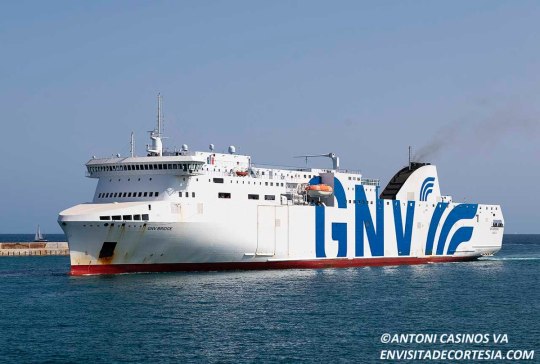
View On WordPress
#2021#cambio climático#GNV#GNV Bridge#Grandi Navi Veloci#medioambiente#Naos Design#primera escala#Wing Sail Module#WingSails
0 notes
Text
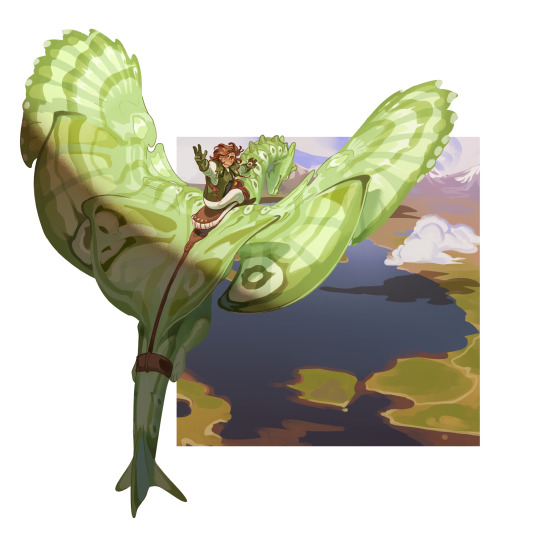
estibarith & rider (some guy. idk who that is)
she has a typical green dragon conformation. i liked the idea of caterpillar imagery?? so spiracle markings along her side as well as (eventually) large eye spots on the second wingsail when she's in season (i may be taking liberties but in canon dragons do get darker around mating time so i'll call it plausible). the wing lineart was massively complicated and i despaired the whole time 👍
she has a relatively large vertical stabiliser due to her short body and stubby tail. this keeps her stable in the air and prevents uncontrolled yaw. but like most greens the aerodynamic drag is tiring for her, and her flight, while incredibly precise and acrobatic, is highly inefficient.
#estibarith is named after his daemon in a daemon au. yes i made one of those as well#it's estibariz really but pern naming conventions...#dragon riders of pern#(the rider is félix)#pern story
668 notes
·
View notes
Text
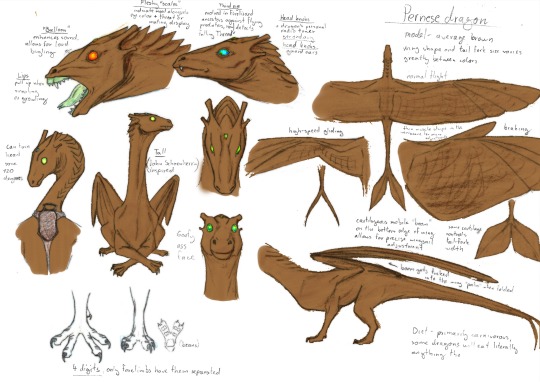
fuck yeah dragons
used the Chris S. Baily design as the base since Dragonchoice was my introduction to Dragonriders of Pern. the wings and tail are loosely based on @/ranticore awesome designs, it's still somewhat insect-based but with the frequent usage of the word "wingsail" across Pern-related writing I decided to give it a bit of an Age of Sail twist inspired by a fore-and-aft sail rig
the third eye is rather primitive and doesn't change color based on the dragon's mood, it always has sort of a rainbow opal appearance
kinda tempted to make a physical model of the dragon at least to see what the wing folding would look like
Transcript of the notes under Read More
Transcript of the notes, starting with the title in the top right corner:
Pernese dragon. Model - average brown.
Wing shape and tail fork size varies greatly between colors
(Next to the first wing diagram) Normal flight
(Next to left side wing diagram) High-speed gliding
(Next to right side wing diagram) Braking
Thin muscle strips in the wing membrane for micro-adjustments
Cartilaginous mobile "boom" along the bottom edge of the wing allows for precise wing sail adjustment
Same cartilage controls tail fork width
The boom gets tucked into the wing "palm" when folded
Diet - primarily carnivorous, some dragons will eat literally anything tho
Notes for the face and body details:
"Balloon" on top of the snout enhances sound, allows for loud bugling
Fleshy "scales" along the neck indicate mood alongside eye color + threat or mating display
Third eye evolved in fire lizard ancestors against flying predators, now detects falling Thread
Head knobs - a dragon's personal rádio tower. Secondary head knobs guard the ears
Can turn the head some 120 degrees
Tall, inspired by the John Schoenherr drawings
(Next to the front view drawing of the head) Goofy ass face
4 digits, only forelimbs have them separated
(I'm aware the notes are pretty chaotic, I was writing them in a rush, but I'm planning to redraw the whole thing with better descriptions and more details)
50 notes
·
View notes
Text
New UK wind propulsion technology ready to hit markets
The UK was leading the world in the use of wind propulsion in shipping, with maritime engineering start-up WingTek winning a £2.2m ($2.8m) innovation grant to develop the WingTek Wingsail, Splash247.com reported.
The project will deliver two full-size operational prototypes: one ashore for long-term testing and development, and one to be installed on a commercial UK vessel for sea trials. The project is scheduled to be finalised by March 2025.
Smart Green Shipping, another UK wind propulsion specialist, has begun onshore trials of its FastRig technology, an aluminium wing sail. Proponents of the technology claim it can reduce emissions from shipping by up to 30 per cent.
Read more HERE

#world news#world politics#news#europe#european news#uk#uk politics#uk news#england#united kingdom#energy#energy saving#wind power#green power
5 notes
·
View notes
Text
Regardless of whether or not they’re realistic I have to say spoon-wings (which, great term) just look fucking stupid in my opinion. I grew up with dragons with big broad wingsails, look like they can stir up a windstorm with a single flap, this fucking ‘I strapped half an umbrella to each arm now watch me jump off the roof’ shit does not impress me.
4 notes
·
View notes
Text
2010s Frozen Mana Comics message boards trying to suss out who the Albatross writers want to win the America’s Cup by looking at how the heroes’ team is portrayed and getting into flame wars.
“See, we’re supposed to support the team based in Auckland who were started by the Peter Blake analogue and have the Dean Barker analogue as their skipper!”
“NZ Spirit are clearly ETNZ!”
“Who are defenders backed by an American tech mogul, introduced foiling and wingsails, and have the Russell Coutts analogue in their management.”
“NZ Spirit are clearly OTUSA!”
0 notes
Text
Sails and Satellite Navigation Could Cut Shipping Industry’s Emissions by up to a Third - Technology Org
New Post has been published on https://thedigitalinsider.com/sails-and-satellite-navigation-could-cut-shipping-industrys-emissions-by-up-to-a-third-technology-org/
Sails and Satellite Navigation Could Cut Shipping Industry’s Emissions by up to a Third - Technology Org
In the vast expanse of the world’s oceans, a shipping industry transformation is underway.
The international shipping sector, made up of thousands of massive cargo ships laden with many of the goods we buy, emits carbon dioxide (CO₂) roughly equivalent to the entire country of Germany.
A cargo vessel with Flettner rotors – a modern equivalent to sails. Image credit: Norsepower
Our research emphasises the need for immediate action. Reducing shipping emissions by 34% by 2030 is necessary to stay on course with the Paris Agreement’s 1.5°C goal. But with low-carbon fuel pipelines unlikely to be available at the necessary scale until at least the 2030s, how can the industry meet its short-term target?
Enter a new solution with ancient origins: sails. Not the billowing canvases of centuries past but high-tech systems capable of harnessing renewable wind energy to supplement the propulsion from a ship’s engine.
A number of advanced sail designs are gaining the attention of shipping firms. Two contenders include Flettner rotors, cylinders that spin to generate propulsion, and “wingsails”, which resemble aeroplane wings and are derived from designs used in yacht racing.
Wind propulsion allows ships to use less fuel and so emit less greenhouse gas. However, in our new paper, we found that the real opportunity to slash emissions from shipping this decade lies in combining sails with optimal routes plotted by satellite navigation systems.
Wingsails, analogous to aeroplane wings, provide lift on either side. Image credit: Smart Green Shipping, CC BY-ND
An old idea with new technology
Optimised routing is a familiar concept to most of us. You’ll have used it by typing a destination into Google Maps and allowing its algorithms to calculate the quickest way for you to arrive at your destination.
The process is similar for ships. But instead of finding the quickest journey, the software models the ship’s performance in water to calculate routes and speeds that minimise fuel use.
With optimised routing and sails, ships can deviate from their standard course to seek out favourable winds. The ship may travel a longer distance but the extra power gained by the sails limits the ship’s fuel consumption and reduces the total emissions over the full journey. The software only suggests routes that guarantee the same arrival time, keeping the ship to its original schedule.
We used a computer model simulation of a cargo vessel with four sails, each taller than Brazil’s Christ the Redeemer statue at 35 meters high. By calculating the fuel consumption of this large bulk carrier ship on over 100,000 journeys spanning four years and covering 14 shipping routes worldwide, we found that sails can cut annual carbon emissions by around 10%.
Flettner rotors are smooth cylinders with discs that spin as wind passes at right angles across it. Image credit: Norsepower, CC BY-ND
The true promise of sails unfolds when optimal routing is used, increasing annual emission cuts to 17%.
Routes with ideal wind conditions have even greater potential. The most promising are typically those far from the equator, such as transatlantic and transpacific crossings, where strong winds can fill large sails. By taking advantage of wind patterns moving across the ocean on these routes, sails and optimised routing can cut annual emissions by over 30%.
Take the journey between the UK and the US as an example. A ship setting out on this voyage will typically experience strong headwinds which generate drag and push the ship backwards, meaning more fuel must be burned to maintain the same forward momentum. But by using sails and optimised routing software on this crossing, ships can avoid these headwinds and steer into more favourable winds.
On the return journey, the ship would typically experience strong winds from behind and the side, which would fill the sails and push the ship on. With optimised routing software the ship can find even stronger winds and fine-tune its direction for the sails to maximise propulsion.
Keeping the 1.5°C target afloat
The International Maritime Organization (the UN agency responsible for environmental regulation in shipping) has a target of cutting greenhouse gas emissions by 20%-30% by 2030. The Paris Agreement’s 1.5°C target requires even deeper cuts.
Our research shows that cuts to CO₂ of this magnitude are possible this decade using wind propulsion and optimised routing on promising routes. Achieving this will oblige the shipping industry to deploy existing technologies and practices and shift its focus from fuel alone, as zero-carbon fuels will take longer to develop.
As we sail further into the 21st century, our research delivers a clear message to the shipping industry: substantial carbon reductions are feasible this decade. Here is an old idea, one that integrates technology with tradition, that can steer international shipping towards its climate goals.
Source: University of Manchester
You can offer your link to a page which is relevant to the topic of this post.
#000#Algorithms#Brazil#carbon#Carbon dioxide#carbon emission#carbon emissions#Chemistry & materials science news#climate#computer#course#cutting#direction#Emissions#energy#Energy & fuel news#engine#Environmental#fuel#Full#Fundamental physics news#gas#Germany#Google#google maps#green#greenhouse#greenhouse gas#greenhouse gas emissions#how
0 notes
Text
Launch HN: OutSail (YC W23) – Wingsails to reduce cargo ship fuel consumption
https://news.ycombinator.com/item?id=35426482 Comments
0 notes
Link
#AYRO#AYROWingsail#Barcelona#Batene#boatelectrification#Candela#CannesYachtingFestival#ElectricVehicle#electricyacht#EV#FluxMarine#France#Futurride#InternationalMultihullShow#LaGrandeMotte#LFP#lithiumironphosphate#OceanZero#SeriesAfunding#solar-electriccatamarans#Spain#sustainablemobility#TED#TEDCountdowninitiative#VPLPDesign#Wingsail#ZENYachts#ZEN50#ZeroEmissionNautic
0 notes
Text
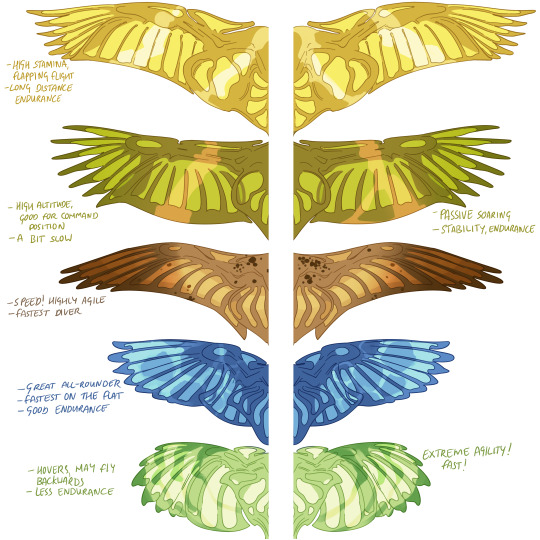
I wanted to keep drawing some pern dragon stuff because I'm now writing a full AU set in weyr but I didn't want to put this stuff on my main blog or patreon due to it being basically for my own reference, though i felt others would like it too! so here is My Take On Dragon Wings By Type...
It's no secret I love drawing bird wings and prefer them a lot over traditional dragon wings. Growing up, I read the pern books featuring cover art of dragonfly-like wings with lots of little translucent panels, which I always loved. So I thought I'd try to nail down some wing shapes & structures by blending those two things i like together. I am aware dragons fly by telekinesis but I prefer a more realistic type of creature design so I will be choosing to ignore that fact. I do not care about strict canon compliance but I do like to keep some of that framework there as well, for fun.
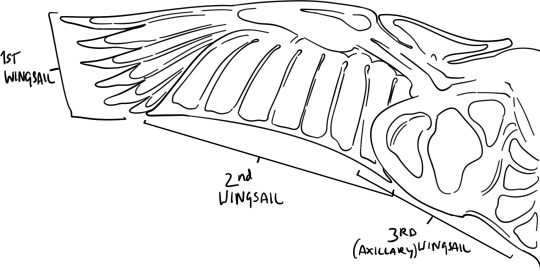
The wing is made up of three main sails, as well as a propatagium sail (in front of the elbow). They are relatively polymorphic and can expand or contract to an extent to change the shape of the wing in response to flight demands, like the wing of an airliner. The trailing edge can expand and the slots between the spars of the 1st wingsail can deepen or become shallower (where those are a feature). The main structural matrix is opaque, while the membranous 'sails' are translucent and let light through like stained glass. These are a bilayer of membrane with air sandwiched between, which forms part of the air sac & respiratory system.
It makes sense for the original engineers of dragons to diversify dragon wing types by colour so that when fighting Thread, there's a dragon for every conceivable aerial job.
[individual descriptions under the cut]
Queens have the longest wings, though the largest bronzes can rival them for surface area. Gold wings are high endurance - a queen can fly further than any other dragon in active level flight, leaving even the swiftest bronzes behind if they can't muster up the energy reserves to catch her. She is an effective flier at all elevations and can pass very low over terrain without issue as well; she is an expert at taking advantage of the ground effect, where extra lift is generated within one half of a wingspan above land. This way, she can pass low below the main wings fighting Thread to catch any stragglers without expending too much energy. However, she is not very agile and may need a bit of a run-up or cliff-edge to get airborne.
Bronzes are suited for command positions during Threadfall, rising highest and maintaining that altitude effortlessly by soaring on thermals. From this vantage point they can easily survey the wings of riders below and make tactical decisions to direct the tide of battle. They have the size and stamina to chase queens, but might find it difficult to keep up on the flat, so they continually select for fitter hatchlings as only the best manage to mate. It takes a very clever and agile bronze to catch a green, if they are so inclined.
Browns are swift, highly agile, and the fastest vertical fliers, ideal for diving through the Thread mass from top to bottom while the other types pass horizontally. During earlier Passes, browns were capable of using their speed to catch queens, but as queen & bronze endurance gradually increased, browns struggle to keep up if they haven't managed to immediately catch their mate in the starting scrum, which is unlikely due to the bulkier bronze dragons being able to shove the browns aside.
Blues are fast on the flat and nicely manoeuvrable, with enough endurance to last a full Threadfall. Good all-rounders with a characteristic vertical take-off, they work best in the horizontal plane in battle but really they can do a little bit of everything. They often beat browns to catch greens, being very precise in flight and almost as manoeuvrable as their green mates.
Greens make up for their low stamina with their extreme manoeuvrability. Their short and elliptical wings let them turn on a dime, hover, and even fly backwards if they are sufficiently skilled. They have the fastest wingbeats, flying with a distinct thrumming sound. Of all the types they are least likely to be hit by a stray Thread, but they tire easily on the flat and have no soaring ability at all, often tapping out midway through battle in favour of replacements. In battle, greens excel at catching odd and skewed clumps of Thread that don't fall as predicted, or ones that are missed by the other riders. Green mating flights are a whole different beast to gold mating flights, where extreme aerial acrobatics are favoured instead of endurance and altitude, and these flights may be over within seconds. You need to be able to withstand a Lot of G-force to be a green rider.
431 notes
·
View notes
Photo
Young Me obviously never realized they had a wingsail catamaran in the awesome-and-sometimes-terrifying 90s Jonny Quest series, but holy crud, they did! In 1996!
Colin’s future expedition ship should totally be like the Questor.

#the seas in arts and culture#sailing#ships#the sea#the real adventures of jonny quest#The Golden Generation
6 notes
·
View notes
Photo




“Wisamo” Project!
The wing sail mobility (WISAMO) project is an automated, telescopic, inflatable wing sail system that can be fitted on both merchant ships and pleasure crafts.
The inflatable wing sail harnesses the wind, a free, universal and inexhaustible source propulsion.
Its revolutionary design enables a ship to reduce its fuel consumption and thereby have a positive impact on the environment by lowering CO2 emissions.
The WISAMO design will be fitted on a merchant ship in 2022 and Michelin expects it to go into production following completion of the trial phase.
Engineered by Michelin and powered by wind (Movin On)
#art#design#sustainability#eco-friendly#wisamo#wing#sailinglife#sailing#inflatable#wingsail#propulsion#CO2#movinon#automated#boat#ship#concept#sailinggif#boatgif#cargoship#vessel#decarbonization#sustainable energy#mobility#sustainable mobility
341 notes
·
View notes
Text
Personified F-50 Headcanons:
AUS— Roo (“The Flying Roo”)
Short auburn hair, with one yellow and one green streak in her bangs. (Art here.) Confident, bold, and sometimes mischievous, she clearly takes after her captain. She doesn’t have any memories of her hull being the Artemis AC-50 in AC 35, but she can speak Swedish and she does like the meatballs.
CAN— Spirit (Same as hull)
Black-haired, possibly part-Native. Since her hull’s named for an orca, she’s made them her symbol and has an orca-colored backpack and a decal of one on her skateboard. Paranoid meticulous about checking the weather report after she was damaged in a windstorm the day of her debut.
DEN— Holger (Sometimes called “Holger Danske” in Season 3 for the Viking on his sail, but I don’t know if that was an official name)
Blond, bearded, but not quite the fearsome warrior his namesake was. (Art here.) More of a sweet, slightly-dorky computer expert who spends a lot of time looking at his post-race analytics. Unsurprisingly loves LEGOs and keeps petitioning the company to make an official SailGP set.
ESP— Vicky (“Victoria”, has been called “Vicky” for short in Tweets and videos)
Curly dark hair with highlights, tanned. With Miró’s sun on her wingsail, she’s an artist, and loves to paint, sketch, and take photos. Her photography skill, capabilities as a racing catamaran, and ability to communicate in many languages fluently mean she’s a great photojournalist and asset to SailGP’s media team.
FRA— Gérard (No hull name?)
Dark hair, usually a bit stubbly— “Franck Cammas but as a teenager”. Insists his last name is Gérard Tabarly, because he’s an offshore racing fan, probably hero-worships Ultims. Blamed himself for Billy Besson leaving the team and had a self-esteem crisis for a while, but is getting more confident, as seen in this story.
GBR— Rita (Same as hull)
Art here. Very interested in clothing and fashion, given her many livery changes. Her accent, hair color and style, and natural speed and agility mean she’s very good at cosplaying as Tracer from Overwatch, even though she can’t teleport. (We think.) Somehow never gets confused around Ben Ainslie’s many previous commands that are also named Rita.
GER— Ludwig (No hull name?)
The new guy, so not too many thoughts on him yet. Probably brunet. Sleeps listening to classical music. Maybe a neat freak always cleaning things based on his hull being so white and shiny?
NZL— Amokura (Same as hull)
Māori, has blue streaks in hair the same shade as the blue on her hull. Rivalry (of course) with Roo. Worried about living up to the legacy of Burling and Tuke’s America’s Cup commands, Te Rehutai and especially Aotearoa (as a fellow multihull), especially given her early struggles in the league, but bonding with Pete and spending her downtime after the lightning strike meeting and training with her ETNZ relatives has taken off a lot of that pressure.
SUI— Elias (“Eiger”)
Platinum-blond hair, tightly curled. Whereas most of the Alinghi avatars over the years have been artistic to some degree, he’s more mechanically- and technically-minded.
USA— Layla (“Eagle” now, but her hull was called “Lady Liberty” because of her sail art in some older sources)
Long red hair, usually in a ponytail. Doesn’t have memories of her previous incarnation as the last USA-17, but she did probably bond more quickly with Jimmy Spithill because of that prior history. BFFs with most of her team’s Female Pathway Program members because CJ Perez’s frustration with being the only teenage girl around resonated with her.
1 note
·
View note
Photo

Sailing - Hair stand up back of neck and goose bumps story challenge @eve_poetry @evepoetrygroup #evestorychallenge - Wow! This was a great inspirational story challenge for me. What a great mind tickler! Thank you!👏🌹 🕊💞💞💞🕊 . . . #sailing #hairsstanduponmyneck #goosebumps #storychallenge #storyprompts #storytheme #stories #testiments #sea #seashore #sailingweather #relaxation #fun #cocktails #atsea #wingsail #waves #360waves #wavesonspin #wavesofthoughts #current #tranquille #tranquill #calm #silhouette #spirit #godzillion100 #evereadmypoem #beingyoubeingtrue https://www.instagram.com/godzillion100/p/Bu2XJ1WlvXh/?utm_source=ig_tumblr_share&igshid=12yv14szg2bgp
#evestorychallenge#sailing#hairsstanduponmyneck#goosebumps#storychallenge#storyprompts#storytheme#stories#testiments#sea#seashore#sailingweather#relaxation#fun#cocktails#atsea#wingsail#waves#360waves#wavesonspin#wavesofthoughts#current#tranquille#tranquill#calm#silhouette#spirit#godzillion100#evereadmypoem#beingyoubeingtrue
0 notes
Text
Okay, three mythical daemons, because I remembered I have Alan’s sister settle as a cockatrice, with descriptions because I like having a specific appearance for this shit and you can’t do that with other people’s art. Also they play in different ways than I do.
~~
Zak Saturday- Aurora (she/her)
Amphithere: serpent with two bat-like wings and a thagomizer on the tail, feathers along the arm of the wings in soft oranges, reds, and pinks, scale coloration dark pine green, soft, light aquamarine underbelly and wingsail, prominent brow ridge reminiscent of horned viper species, eye color: gold, rear-fanged, length- ~3 ft, wingspan- ~40 in
Holger Holgaart- Sindri (he/his)
Unicorn: ass-like equine with singular smooth horn on forehead, red-brown back, neck, head, and legs, white belly, rump, nose, mane and tail, black socks and horn, eye color: light brown, height- ~4ft at withers, horn length- 18in
Sarah Albright- Queen (she/her)
Cockatrice: a vaguely avian-shaped reptile with a long, serpentine tail, rooster-like head, comb, wattles, and legs, wings are bat-like, featherless instead possessing rough scales and scutes, tough spines run down back and tail, carbuncles and legs muddled red-brown, body and head dull olive green, eye color: yellow, height- ~28in, length- ~30in, wingspan- ~3ft
Males’ body and head bright yellows, greens, and blues
.
#leave a little spot in case i wanna do this for other fuckers at a later date#technically lee also has a mythical daemon#but tatzelwyrms are common in the setting so everyone can take a solid guess there
4 notes
·
View notes